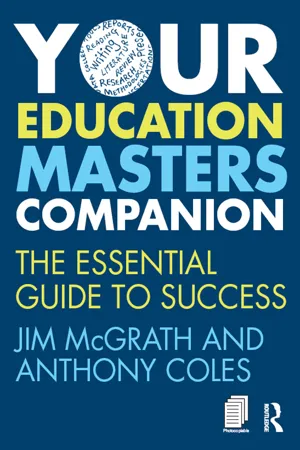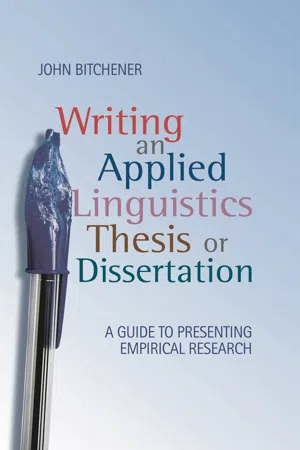Literature Review
A literature review is a critical analysis of existing literature on a specific topic. It involves identifying, evaluating, and synthesizing relevant sources to provide a comprehensive understanding of the subject. The purpose of a literature review is to establish the current state of knowledge, identify gaps, and highlight areas for further research.
8 Key excerpts on "Literature Review"
- Michael Coughlan, Patricia Cronin(Authors)
- 2020(Publication Date)
- SAGE Publications Ltd(Publisher)
...A Literature Review is a summary, with critical analysis, of the outcomes of a number of pieces of research on a selected topic (Baker, 2016). That summary should include the synthesis of data to identify new knowledge and identify any gaps in the literature (Neill, 2017). Rather than having to read a multiplicity of studies on a topic, a comprehensive review should provide the reader with a succinct, objective and logical summary of the current knowledge on that particular subject. The literature should have been gathered in a systematic manner, to ensure all the relevant information has been included, and the critical appraisal allows the reader to make a judgement on how robust the original studies were. A Literature Review is not an essay where studies can be selected to support a particular view or opinion. Nor is it a series of critiques or lengthy descriptions of a number of studies. Quite simply, the Literature Review provides a critical discussion on the topic of interest while pointing out similarities and inconsistencies in existing relevant literature. It is important to note that while a literature search is the means of helping you to unearth literature that is appropriate to your review topic, a Literature Review is the larger process which includes identifying the topic of interest, gathering, critically appraising and summarising the literature. The term Literature Review today encompasses a number of different appro-aches to searching, gathering and presenting literature (Cronin et al., 2015). These include the traditional or narrative review – which is similar to the Literature Review in research study – scoping review and systematic review, among others. Systematic reviews can involve meta-analysis or meta-synthesis to analyse the data discovered and are regarded as research in their own right...
- Bruce B. Frey(Author)
- 2018(Publication Date)
- SAGE Publications, Inc(Publisher)
...Jackie Waterfield Jackie Waterfield Waterfield, Jackie Literature Review Literature Review 983 987 Literature Review The term Literature Review can be viewed as both what is read and the process that has been undertaken to produce the work in question. Broadly, it denotes the bringing together and summary or synthesis of previous published work. In the academic literature, the terms review, Literature Review, descriptive review, systematic review, and narrative review are often used. At times, such terminology denotes specific distinctions between different types of review, but on other occasions some of the terms are used interchangeably. The term Literature Review covers a range of approaches. This entry first discusses Literature Reviews in education. It then describes narrative reviews and systematic reviews, before explaining two approaches commonly used in systematic reviews, meta-analysis, and metasynthesis. Literature Reviews in Education Literature Reviews are seen in academic writing, both in students’ essays and theses and in professional peer-reviewed journals. The purpose in the former is most commonly either as a very circumscribed piece of written work for an assessment or to create a rationale for an individual’s research. In the latter, it may well be a resource to influence policy, to guide practice, or to identify gaps in knowledge and influence future research. In an educational thesis, students demonstrate through the Literature Review their knowledge and understanding of the research and theories in their field of study and, by critiquing others’ work, position themselves and the focus of their research. The review therefore gives both a theoretical framework and a methodological rationale for the student’s research. These reviews are of the traditional type...
- eBook - ePub
- Gail Craswell, Megan Poore(Authors)
- 2011(Publication Date)
- SAGE Publications Ltd(Publisher)
...As a piece of writing, the Literature Review must be defined by a guiding concept (e.g., your research objective, the problem or issue you are discussing, or your argumentative thesis). It is not just a descriptive list of the material available, or a set of summaries. (undated) In short, an ‘effective review creates a firm foundation for advancing knowledge’ (Webster and Watson, 2002: xiii). key points The Literature Review provides a rationale for your research in terms of what has gone before, a justification of its value and significance. Writing tasks engaged In order to fulfil the purposes of a Literature Review, you will engage writing tasks of the following types (depending on the nature of your research): Demonstrating through engagement with the literature that you have a thorough critical understanding of the literature. That is, you will be critically appraising strengths and weaknesses of the literature relevant to your own research. Pointing out gaps in the literature, identifying problems remaining to be solved or issues needing to be addressed and so forth. Drawing together the main themes and arguments of a particular body or bodies of literature. Developing arguments in the process of reviewing the literature. Showing how your research fits in with what has already been done so as to justify its value and communicate the nature of your contribution (sometimes occurs in a separate section). Review mode and orientation With a formal Literature Review, review mode means moving from review of the literature to points being made in building your arguments, like so: (From: review of literature) → (To: points abstracted from the review to develop your discussion) In short, keep your eye firmly on the literature when writing your review. All Literature Reviews have a strong research orientation in that they engage the relevant research and show how the individual student’s research fits in...
- eBook - ePub
School-based Research
A Guide for Education Students
- Elaine Wilson(Author)
- 2017(Publication Date)
- SAGE Publications Ltd(Publisher)
...Distinguish between respecting the authors as people and being sceptical about what they write. Keep an open mind, retaining a conditional willingness to be convinced: Has the author evaluated the literature relevant to the problem or issue? Does the author include literature that takes positions that she or he does not agree with? Checking for Relevance Check that everything that the authors have written is relevant to their purpose in writing the account and the argument they develop: In material written for a popular readership, does the author use appeals to emotion, one-sided examples or rhetorically charged language and tone? Is there an objective basis to the reasoning or is the author merely ‘proving’ what he or she already believes? Writing a Literature Review Having completed your search and synthesized your ideas, the final outcome of the process will take the form of a written Literature Review. The purpose of the review is to inform your audience of what is happening in the area. It will also establish you as a credible, well-informed and capable researcher. Additionally, if well constructed, it will help provide a context for your own approach, argue for the relevance and significance of your research question and justify the appropriateness of your approach. A good Literature Review is not just a summary of everything that you have read but, rather, is a well-reasoned purposeful argument that supports your research focus. Therefore, you need to be analytical of the key ideas and then synthesize these into a coherent section of your essay or thesis. In other words, not only do you need to know what research has been done in the area but you will also need to demonstrate that you understand how all the ideas relate to each other...
- eBook - ePub
Your Education Masters Companion
The essential guide to success
- Jim McGrath, Anthony Coles(Authors)
- 2015(Publication Date)
- Routledge(Publisher)
...You will be familiar with writing essays where you discuss what writers have said as part of the general discussion that forms the body of your work (see 9.4). However, many students find it difficult to discuss and evaluate their literature in one section and then use it in the findings to analyse, challenge, support and interpret the data they have collected. However, once you’ve done it a few times you’ll find it relatively easy. Warning: Avoid the situation where the first stand-alone Literature Review that you write is for your dissertation. Get some practice in before then. It’s only when you review the literature that you start to uncover the different perspectives on a topic and the arguments that rage among practitioners. This chapter will give you the information you need to find, critically evaluate and write up a Literature Review that can be properly described as a conceptual framework. A conceptual framework is the body of theory that you are going to use to analyse and interpret your findings. For example, you could explore the growth of free schools and academies from either a communist/socialist perspective or a free market liberal/conservative perspective. Many students worry that they may miss a vital article or book when searching for literature. This is unlikely. If you read four or five relevant articles that are up to date, they will probably contain over 100 references between them. Any seminal work in your area is very likely to be in that extended list. You will quickly identify seminal works by (a) What other writers say about a particular book or article and (b) The frequency by which it’s referenced by other writers. 5.2 Undertaking a literature search Remember: There are as many ways to undertake a Literature Review as there are students. The important point is to find the way that suits you best. There is no perfect way to do a literature search...
- eBook - ePub
Research Skills for Teachers
From research question to research design
- Beverley Moriarty(Author)
- 2020(Publication Date)
- Routledge(Publisher)
...4 Understanding and completing a Literature Review hThis chapter will help you to: locate and read evidence-based research articles and other literature relating to your topic, problem, broad research question and draft research question/s develop a conceptual framework, write a critical Literature Review and reassess your research questions. The ideal time to start working intensively on your Literature Review is after you decide on a topic and a problem and learn how to draft one or two research questions in your area of interest before making decisions about your research design and your methods of data collection. Your draft research question/s will guide your search for evidence-based research articles on your topic and what you find out from your Literature Review will help you to refine the focus of your study, your specific research question/s and how you wish to conduct your study. Research design The broad approach or framework employed to investigate or explore a topic or problem and the research question. Research designs can be quantitative (for example, experiments) or qualitative, or use mixed methods (combining quantitative and qualitative). Evidencebased research articles may explicitly identify the design used in the study–for example, a case study or a longitudinal study. Literature Review The central purpose of a Literature Review is to find out what is already known about a specific area of interest and how we know (the design and methods used in previous studies), what still needs to be discovered and how the research builds on previous research or fits into part of a gap left by previous research. The Literature Review leads into the research question/s guiding the study. The central purpose of a Literature Review is to find out: what is already known about your specific area of interest and how we know (the design and methods used in previous studies)...
- eBook - ePub
So, You Have to Write a Literature Review
A Guided Workbook for Engineers
- Catherine Berdanier, Joshua Lenart, Ryan K. Boettger(Authors)
- 2020(Publication Date)
- Wiley-IEEE Press(Publisher)
...As the author you must present your topic in a compelling way, provide relevant (usually not comprehensive) coverage of the research that has been done in an area, address relevant conversations in the field, discuss specific studies that are of special relevance to the project, and establish gaps in the body of the literature. Think of the Literature Review as an inverted triangle, where the broad top of the triangle comprises overarching motivation and background about what is being done in the disciplines, and then each new paragraph continues to focus more explicitly on the details that the author wishes to turn the reader's attention toward (see Figure 2.1). Figure 2.1 The “shape” of the argument of a Literature Review, envisioned as an inverted triangle or funnel from motivation to specific research questions. At the end of the Literature Review, most research articles have an explicit problem or gap statement, followed by the author's specific research questions and (or) research objectives. (Field‐ and advisor‐dependent, these might be statement as actual questions, or it might be written as a statement of purpose.) Regardless of this format, the questions or objectives must align with the established gap. Think of this alignment as a hero narrative wherein you get to play the role of the superhero that exactly fills the gap that you have defined and honed through the Literature Review. To prepare writers for common barriers in writing good Literature Reviews, we address a common misconception before reiterating it in the following chapters when we cover best practices for writing Literature Reviews. Although we call it a “Literature Review” or “Review of the Literature,” our job as writers is not to simply report or summarize on what has been done in the literature...
- eBook - ePub
Writing an Applied Linguistics Thesis or Dissertation
A Guide to Presenting Empirical Research
- John Bitchener(Author)
- 2009(Publication Date)
- Bloomsbury Academic(Publisher)
...In order to do this, there are essentially seven key functions that you should consider. These are presented in Box 4a below. Box 4a Functions of a thesis Literature Review 1. A review of the non-research literature that summarizes and synthesizes background and contextual information 2. A review of theoretical perspectives that underpin or inform your research project 3. A review of the research literature relevant to your study 4. A critique that (a) identifies arguments for and against issues and controversies related to functions 1–3 above and (b) assesses or weighs up the value of theories, ideas, claims, research designs, methods and conclusions, including an identification of strengths and weaknesses. 5. An identification of gaps or shortcomings in this knowledge and research 6. A rationale justifying why the gap was important and significant enough to be filled 7. An explanation of how the design and execution of your research project was informed by steps 1–6 above. This is likely to explain how the literature provided (a) a focus for the research questions or hypotheses that were investigated and (b) guidelines for an appropriate methodology and design As you can see from this list of functions, they form a clear and logical outline for the Literature Review. Understanding these will help you determine the type of content that is relevant to the review and guide you in how to most effectively organize it so that it reveals the ‘argument’ underpinning your study. THE CONTENT AND STRUCTURE OF A THESIS Literature Review The content of the review comprises a series of theme/topic units (frequently signaled by the use of headings and sub-headings like you see in a table of contents) that review the non-research literature (e.g. background and theoretical perspectives) and research literature relevant to your research project (i.e. functions 1–3 above). But, the review is more than just a summary of this material: it includes a critique of this material (i.e...







